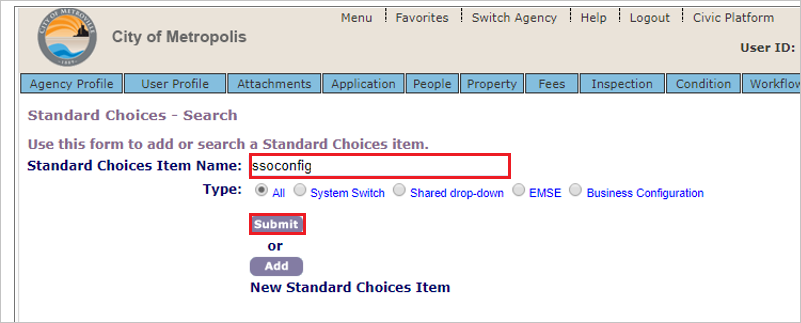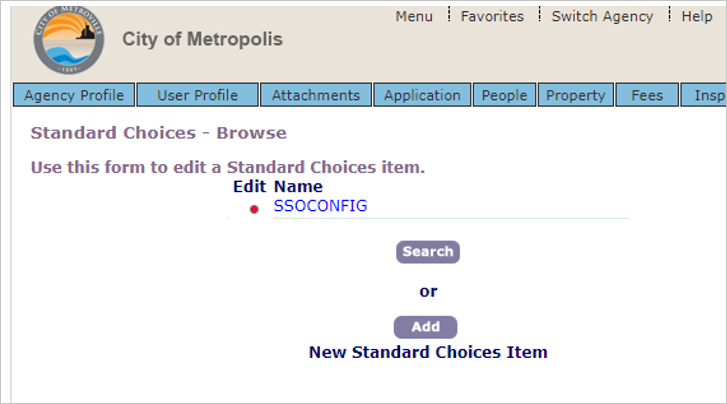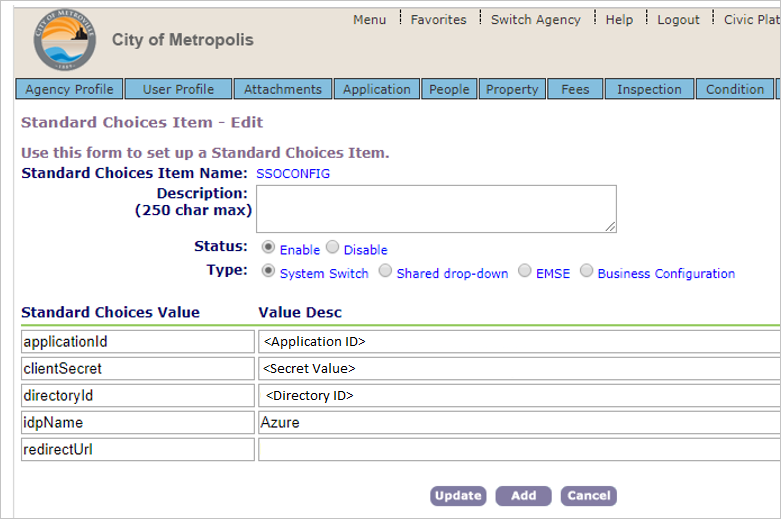Tutorial: Microsoft Entra SSO integration with Civic Platform
In this tutorial, you'll learn how to integrate Civic Platform with Microsoft Entra ID. When you integrate Civic Platform with Microsoft Entra ID, you can:
- Control in Microsoft Entra ID who has access to Civic Platform.
- Enable your users to be automatically signed-in to Civic Platform with their Microsoft Entra accounts.
- Manage your accounts in one central location.
Prerequisites
To get started, you need the following items:
- A Microsoft Entra subscription. If you don't have a subscription, you can get a free account.
- Civic Platform single sign-on (SSO) enabled subscription.
Scenario description
In this tutorial, you configure and test Microsoft Entra SSO in a test environment.
- Civic Platform supports SP initiated SSO.
Note
Identifier of this application is a fixed string value so only one instance can be configured in one tenant.
Add Civic Platform from the gallery
To configure the integration of Civic Platform into Microsoft Entra ID, you need to add Civic Platform from the gallery to your list of managed SaaS apps.
- Sign in to the Microsoft Entra admin center as at least a Cloud Application Administrator.
- Browse to Identity > Applications > Enterprise applications > New application.
- In the Add from the gallery section, type Civic Platform in the search box.
- Select Civic Platform from results panel and then add the app. Wait a few seconds while the app is added to your tenant.
Alternatively, you can also use the Enterprise App Configuration Wizard. In this wizard, you can add an application to your tenant, add users/groups to the app, assign roles, as well as walk through the SSO configuration as well. Learn more about Microsoft 365 wizards.
Configure and test Microsoft Entra SSO for Civic Platform
Configure and test Microsoft Entra SSO with Civic Platform using a test user called B.Simon. For SSO to work, you need to establish a link relationship between a Microsoft Entra user and the related user in Civic Platform.
To configure and test Microsoft Entra SSO with Civic Platform, perform the following steps:
- Configure Microsoft Entra SSO - to enable your users to use this feature.
- Create a Microsoft Entra test user - to test Microsoft Entra single sign-on with B.Simon.
- Assign the Microsoft Entra test user - to enable B.Simon to use Microsoft Entra single sign-on.
- Configure Civic Platform SSO - to configure the single sign-on settings on application side.
- Create Civic Platform test user - to have a counterpart of B.Simon in Civic Platform that is linked to the Microsoft Entra representation of user.
- Test SSO - to verify whether the configuration works.
Configure Microsoft Entra SSO
Follow these steps to enable Microsoft Entra SSO.
Sign in to the Microsoft Entra admin center as at least a Cloud Application Administrator.
Browse to Identity > Applications > Enterprise applications > Civic Platform application integration page, find the Manage section and select Single sign-on.
On the Select a Single sign-on method page, select SAML.
On the Set up Single Sign-On with SAML page, click the pencil icon for Basic SAML Configuration to edit the settings.

On the Basic SAML Configuration section, perform the following steps:
a. In the Identifier (Entity ID) text box, type the value:
civicplatform.accela.comb. In the Sign on URL text box, type a URL using the following pattern:
https://<SUBDOMAIN>.accela.comNote
The Sign on URL value is not real. Update this value with the actual Sign on URL. Contact Civic Platform Client support team to get this value. You can also refer to the patterns shown in the Basic SAML Configuration section.
On the Set up Single Sign-On with SAML page, In the SAML Signing Certificate section, click copy button to copy App Federation Metadata Url and save it on your computer.

Navigate to Identity > Applications > App registrations, select your application.
Copy the Directory (tenant) ID and store it into Notepad.

Copy the Application ID and store it into Notepad.

Navigate to Identity > Applications > App registrations, select your application. Select Certificates & secrets.
Select Client secrets -> New client secret.
Provide a description of the secret, and a duration. When done, select Add.
Note
After saving the client secret, the value of the client secret is displayed. Copy this value because you aren't able to retrieve the key later.

Create a Microsoft Entra test user
In this section, you'll create a test user called B.Simon.
- Sign in to the Microsoft Entra admin center as at least a User Administrator.
- Browse to Identity > Users > All users.
- Select New user > Create new user, at the top of the screen.
- In the User properties, follow these steps:
- In the Display name field, enter
B.Simon. - In the User principal name field, enter the username@companydomain.extension. For example,
B.Simon@contoso.com. - Select the Show password check box, and then write down the value that's displayed in the Password box.
- Select Review + create.
- In the Display name field, enter
- Select Create.
Assign the Microsoft Entra test user
In this section, you'll enable B.Simon to use single sign-on by granting access to Civic Platform.
- Sign in to the Microsoft Entra admin center as at least a Cloud Application Administrator.
- Browse to Identity > Applications > Enterprise applications > Civic Platform.
- In the app's overview page, find the Manage section and select Users and groups.
- Select Add user, then select Users and groups in the Add Assignment dialog.
- In the Users and groups dialog, select B.Simon from the Users list, then click the Select button at the bottom of the screen.
- If you're expecting any role value in the SAML assertion, in the Select Role dialog, select the appropriate role for the user from the list and then click the Select button at the bottom of the screen.
- In the Add Assignment dialog, click the Assign button.
Configure Civic Platform SSO
Open a new web browser window and sign into your Atlassian Cloud company site as an administrator.
Click on Standard Choices.

Create a standard choice ssoconfig.
Search for ssoconfig and submit.

Expand SSOCONFIG by clicking on red dot.

Provide SSO related configuration information in the following step:

In the applicationid field, enter the Application ID value, which you copied previously.
In the clientSecret field, enter the Secret value, which you copied previously.
In the directoryId field, enter the Directory (tenant) ID value, which you copied previously.
Enter the idpName. Ex:-
Azure.
Create Civic Platform test user
In this section, you create a user called B.Simon in Civic Platform. Work with Civic Platform support team to add the users in the Civic Platform Client support team. Users must be created and activated before you use single sign-on.
Test SSO
In this section, you test your Microsoft Entra single sign-on configuration with following options.
Click on Test this application, this will redirect to Civic Platform Sign-on URL where you can initiate the login flow.
Go to Civic Platform Sign-on URL directly and initiate the login flow from there.
You can use Microsoft My Apps. When you click the Civic Platform tile in the My Apps, this will redirect to Civic Platform Sign-on URL. For more information, see Microsoft Entra My Apps.
Next steps
Once you configure Civic Platform you can enforce session control, which protects exfiltration and infiltration of your organization’s sensitive data in real time. Session control extends from Conditional Access. Learn how to enforce session control with Microsoft Defender for Cloud Apps.